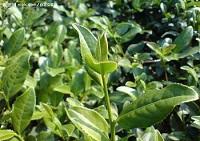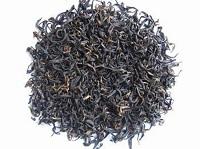Pu-erh Tea (普洱茶)
|
   | Pu-erh tea, also spelled as Pu'er tea, is a variety of fermented dark tea produced in Yunnan province, China.Fermentation is a tea production style in which the tea leaves undergo microbial fermentation and oxidation after they are dried and rolled.[4] This process is a Chinese specialty and produces tea known as Hei Cha (黑茶), commonly translated to dark, or black tea (this type of tea is completely different from what in West is known as "black tea", which in China is called "red tea"). The most famous variety of this category of tea is Pu-erh from Yunnan Province, named after the trading post for dark tea during imperial China.
Pu'er traditionally begins as a raw product known as "rough" Mao Cha (毛茶) and can be sold in this form or pressed into a number of shapes and sold as "raw" Sheng Cha (生茶). Both of these forms then undergo the complex process of gradual fermentation and maturation with time. The recently developed Wo Dui process (渥堆) pioneered by both the Menghai and Kunming Tea Factories has created a new type of pu-erh tea of which some traditionalists dispute the legitimacy. This process involves an accelerated fermentation into "ripe" Shou Cha (熟茶) which is then sold loose or pressed in various shapes. All types or pu-erh can be stored for maturity before consumption and that is why it has become common for the products to be labelled with year and region of production.
Darkening tea leaves to trade with ethnic groups at the borders has a long history in China. These crude teas were of various origins and were meant to be low cost.Darkened tea or Hei Cha, is still the major beverage for the ethnic groups in the southwestern borders and, until the early 1990s, was the third major tea category produced by China mainly for this market segment.
There had been no standardized processing for the darkening of Hei Cha until the postwar years in the 1950s where there was a sudden surge in demand in Hong Kong, perhaps because of the concentration of refugees from the mainland. In the 1970s the improved process was taken back to Yunnan for further development, which has resulted in the various production styles variously referred to as Wo Dui today. This new process produced a finished product in a manner of months that many thought tasted similar to teas aged naturally for 10–15 years and so this period saw a demand-driven boom in the production of Hei Cha by the artificial ripening method.
In recent decades, demand has come full circle and it has become more common again for Hei Cha, including Pu-erh, to be sold as the raw product without the artificial accelerated fermentation process.
Pu-erh tea processing, although straightforward, is complicated by the fact that the tea itself falls into two distinct categories: the "raw" Sheng Cha and the "ripe" Shou Cha. All types of pu-erh tea are created from máochá (毛茶), a mostly unoxidized green tea processed from a "large leaf" variety of Camellia sinensis (C. sinensis assamica) found in the mountains of southern Yunnan.
Maocha can be sold directly to market as loose leaf tea, compressed to produce "raw" Sheng Cha, naturally aged and matured for several year before being compressed to also produce "raw" Sheng Cha or undergo Wo Dui ripening for several months prior to being compressed to produce "ripe" Shou Cha. While unaged and unprocessed, Maocha pu-erh is similar to green tea. Two subtle differences worth noting are that pu-erh is not produced from the small leaf chinese varietal but the broad leaf varietal mostly found in the southern Chinese Provinces and India. The second, is that pu-erh leaves are picked as one bud and 3-4 leaves whilst green tea is picked as one bud and 1-2 leaves. This means that older leaves contribute to the qualities of pu-erh tea.
|
|